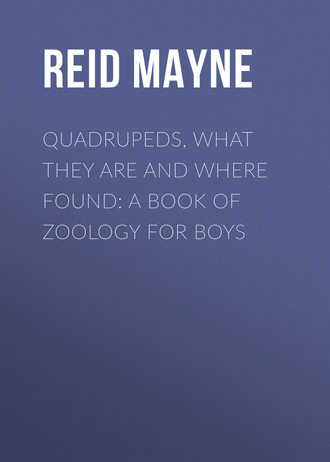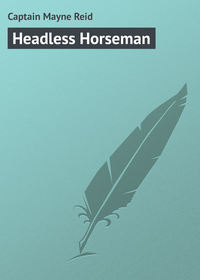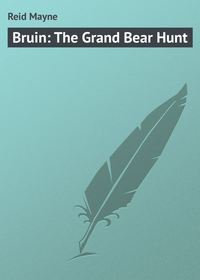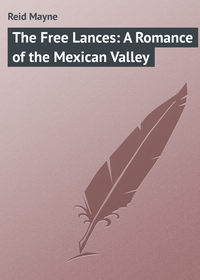 полная версия
полная версияQuadrupeds, What They Are and Where Found: A Book of Zoology for Boys

Mayne Reid
Quadrupeds, What They Are and Where Found: A Book of Zoology for Boys
Preface
I have been called upon to write illustrative sketches to a series of engravings, designed by an eminent artist. In performing my part of the work I have thrown the Mammalia into twenty-four groups – corresponding more or less to the picture designs – and have dwelt chiefly on the geographical distribution of the animals. The Cetaceae and Vespertilionidae are properly omitted.
In the groups given there is no attempt made at any very scientific arrangement. The sketches are purely of a popular character, even the scientific nomenclature being avoided. It is hoped, however, that they may prove of service to the zoological tyro, and form as it were his first stepping-stone to a higher order of classification.
In reality, notwithstanding the prodigious speculations of learned anatomists, no truly good arrangement of the Mammalia has yet been arrived at; the deficiency arising from the fact that, as yet, no true zoologist has had the opportunity of a sufficiently extended observation of the natural habits of animals.
Now, however, that the great agent – steam – has as it were “brought the ends of the earth together,” the opportunity is no longer wanting; and it is to be hoped that a better classification may soon be obtained. Who knows but that some ardent young zoologist, who has taken his first lessons from this little book, may be the man to supply the desideratum? Who knows?
Such a result would be a proud triumph for the author of these monographic sketches.
Mayne Reid.
Chapter One.
Monkeys of the Old World
The great family of the Monkeys, or the “Monkey tribe,” as it is usually called, is divided by naturalists into two large groups – the “Monkeys of the Old World,” or those that inhabit Africa, Asia, and the Asiatic islands; and the “Monkeys of the New World,” or those that belong to America. This classification is neither scientific nor natural, but as it serves to simplify the study of these quadrupeds – or quadrumana, as they are termed – it is here retained. Moreover, as there is no genus of monkey, nor even a species, common to both hemispheres, such a division can do no harm.
The number of species of these animals, both in the Old and New Worlds, is so great, that to give a particular description of each would fill a large volume. It will be only possible in this sketch to point out the countries they inhabit, and to say a word or two of the more remarkable kinds.
In point of precedence, the great Ourang-outang contests the palm with the Chimpanzee. Both these creatures often attain the size of an ordinary man, and individuals of both have been captured exceeding this size; while, at the same time, in muscular strength, one of them is supposed to equal seven or eight men. It is remarkable how little is known of the habits of either. This is accounted for by the fact that they both inhabit regions still unexplored by civilised man, dwelling in thick impenetrable forests, where even the savage himself rarely penetrates.
Although many exaggerated stories are told of these great satyr apes, and many of these are only “sailors’ yarns,” yet it is easy to believe that animals approaching in structure, and even in intelligence, to man himself, must possess habits of the most singular kind. There is little more known of them than there was hundreds of years ago – indeed, we might say thousands of years; for it is evident that the Carthaginians came into contact with the chimpanzee on the western coast of Africa, and through them the Romans became acquainted with it; and no doubt it was this animal that gave origin to most of their stories of satyrs and wild men of the woods.
The chimpanzee is found only in the forests of tropical Africa – more especially along the west coast, the banks of the Gaboon, and other rivers. The ourang-outang is exclusively Asiatic – inhabiting Borneo, Sumatra, the peninsula of Malacca, Cochin China, and several others of the large Oriental islands. Of the ourang-outang there are two species – perhaps three – differing very little, except in point of size and colour.
A group of large tail-less apes, usually denominated Gibbons, or Long-armed Apes, come next in order. These are neither so large nor human-like as the ourang or the chimpanzee; nevertheless, they are capable of walking upon their hind legs, after the manner of bipeds. They are all long-armed apes, and generally use their fore-arms in walking, but more to assist them in clinging to the branches of trees, and swinging themselves from one to the other.
The gibbons are all Asiatic monkeys, and inhabit the same countries with the ourang, viz., the tropical forests of India and the Indian Archipelago. There are at least a dozen species of them, nearly half of which are found in the Island of Sumatra alone.
The Proboscis monkeys follow the gibbons. These are also long-armed apes, but with tails and sharp proboscis-like snouts, from which their name is derived. Only two species are known – both belonging to the great Island of Borneo, so rich in varieties of these human-like mammalia. One of the species of proboscis monkeys has also been observed in Cochin China. Another large tribe of Asiatic apes, containing in all nearly twenty different species, has been constituted into a genus called Semnopithecus. These also inhabit the Indian continent and the great islands; but they are not so exclusively tropical in their habits, since several of the species extend their range northward to Nepaul, and other districts among the Himalaya Mountains. It is a species, or more than one, of these ugly apes that is venerated by the Hindus; and they are permitted to live without molestation in the sacred groves and temples, though they often prove most troublesome protegées to their fanatical benefactors.
In Africa, the representatives of this last-mentioned tribe are found in the Colobus monkeys. Of these there are about a dozen species; and from several of them are obtained the long-haired monkey skins of commerce. They are all tropical animals, and inhabit the middle zone of Africa – their range extending from Abyssinia to the shores of the Atlantic.
Another very large tribe, containing in all as many as thirty species, and belonging exclusively to Africa, are the Guenons. They are closely allied to the colobus monkeys, but yet sufficiently different from them in habits and conformation to be classed into a separate genus. Most of the guenons inhabit the central regions of Africa; but they are not exclusively tropical, since several kinds belong to Kaffraria, and that region indefinitely called the Cape of Good Hope.
The Macaco apes constitute another genus, which forms the link between the guenons and the baboons, or dog-headed monkeys. They are neither exclusively African nor Asiatic monkeys, since species of macacoes are found in both these continents. They are usually subdivided into the macacoes with long tails, and those with short tails; and there is one species which wants this appendage altogether. This is the Magot – perhaps the most noted of all the macacoes, since it was the earliest known to European nations, and is, in fact, the only species that is indigenous to Europe. It is the magot that inhabits the Rock of Gibraltar. Much has been written as to whether this monkey is really indigenous to Europe – some naturalists alleging that it reached Gibraltar from Africa, where it is also common. But it is not generally known that, on European ground, the magot is not confined solely to the Gibraltar Rock. It is also found in other parts of the south of Spain; and, it is likely enough, has existed there long enough to claim the character of a native.
In the chain of natural affinities, the Baboons, or dog-headed monkeys, stand next to the macacoes. These are more of a quadruped form than any yet mentioned; and, both in a moral and physical sense, they are certainly the ugliest of animals. The hideous Drills and Mandrills, so well-known in our menageries, belong to this genus; as also the Chacma, or great dog-monkey of the Cape.
There are, in all, seven or eight species of baboons, and most of them inhabit Africa. One of the most singular of them, the Hamadryas, extends its range into Arabia; while another, the Black Baboon, is an inhabitant of the Philippine Isles.
With the baboons we close our list of the Monkeys of the Old World; but, in order to complete the account of these quadruped mammalia, it is necessary to find a place for those strange creatures usually known as Lemurs. These are usually grouped by themselves, and in a classification succeed the American monkeys – to some of which they have a greater resemblance than to those of the Old World; but, as they are all exclusively inhabitants of the latter, they may appropriately be noticed here.
The Lemurs are animals having very much the appearance and habits of monkeys, but with long snouts or muzzles, resembling that of the fox. Hence they are sometimes called fox-apes. There are many kinds of them, however; and, although classed in a group called lemurs, they differ exceedingly from one another, some of them having the appearance of foxes, others more resembling squirrels, and still others like flying squirrels – being possessed of a similar wing-like appendage, and capable, like them, of extended flight. They are known under different appellations, as Makis, Indris, Loris, Galagos, Tarsiers, Ay-ays, etcetera, and naturalists have subdivided them into a great number of genera. They are found both in Africa and Asia; but by far the greater number of them, as the Makis and Ay-ays, belong to the Island of Madagascar. The last are not to be confounded with an animal bearing the same name – the ay-ay of America. The latter is the singular creature known as the sloth, of which there are several distinct species, all inhabitants of the great forests of tropical America.
Of the lemurs, at least thirty different kinds are known, more than half of which belong to the Island of Madagascar. A few species are found on the west coast of Africa: and the others inhabit the Oriental islands – Ceylon, Java, Sumatra, Timor, Mindanao, and the Philippine Archipelago.
Chapter Two.
Monkeys of the New World
The Monkeys of America differ in many respects from those of the Old World. In general they are smaller – none of the species being quite so large as the baboons. Their bodies and limbs are also more slender and spider-like; and their whole conformation seems intended to adapt them for dwelling in the great virgin forests of the New World. There is one particular in which they differ most remarkably from their congeners of the Old World; that is, in having prehensile tails. With these they are enabled to suspend themselves from the branches of trees, or swing their bodies from one to the other; and this prehensile power is far greater than could be obtained by any clutch of the hand. So great is it, that even after the animal has died from the effect of a shot or other wound, its tail will still remain hooped around the branch; and if the body is not taken down by the hunter, it will hang there till released by the decay of the tail!
Not all the monkeys of America possess this prehensile power of tail. Some are entirely without it, and approach nearer to certain kinds in the Old World; while there are a few species that very closely resemble the lemurs. These differences have led to a classification of the American monkeys; and they have been thrown into three groups, though it may be remarked that these groups are not very natural.
They are as follow: – The Sapajous, whose tails are not only prehensile, but naked underneath, and tubercled near the tips; the Sajoas, who possess the prehensile power, but have hairy tails; and the Sajouins, whose tails are not prehensile.
For want of a better, this classification may be adopted.
The Sapajous are subdivided into three genera, of which the Howlers form one. They are so denominated from their habit of assembling in troops, and uttering the most terrible howlings, so loud that the forest is filled with their sonorous voices. Their cries can be heard at a half-league’s distance, and produce upon a stranger unaccustomed to such sounds a very disagreeable impression. The unusual strength of voice is accounted for by a peculiar drum-like construction of the os hyoides, common to all the genera of Sapajous, but more developed in some than in others; and those in whom the voice is loudest constitute the genus of Alouatles, or Howlers.
Of the true howlers there are about a dozen species known to naturalists. Most of them are denizens of the tropical forests of Guiana and Brazil; but some species are not so tropical in their habits, since one or two extend the kingdom of the monkeys into Mexico on the north, and southward to Paraguay.
Closely allied to the last, are the Ateles, or Spider monkeys. These derive their generic name from their singular spider-like appearance – caused by their disproportionately long and slender limbs, and the great length of their tails. None equal them in the prehensile power of the caudal appendage; and it is of them that that curious story is related – the story of the Monkeys’ Bridge – where it is told how they pass over a stream: a number of the strongest joining their bodies together by means of their long tails, and thus forming a bridge, by which the whole troop are enabled to cross.
Of the spider monkeys there are about a dozen species; but three of these have been taken to form one of the three genera into which, as already stated, the Sapajous are divided. These three differ very little from the other spider monkeys, except in being covered with a soft, woolly hair; and, furthermore, in being much more rare than the others; at all events, they are more rarely seen, as they dwell only in the thickest forests, far remote from the habitations of man.
The third and last genus of the Sapajous is that termed Lagothrix. They are small monkeys, covered also with soft woolly hair; and their habitat is along the banks of rivers. They have a strange habit, not observable among their congeners, of collecting in small troops, and rolling or “clewing” themselves up together. This they do in cold weather, or on the approach of a storm. They summon each other by means of signals and cries; and selecting the convenient bifurcation of some tree, they there form the singular group. The jaguar and other beasts of prey take advantage of this habit, and often make victims of the whole tableau vivant! There are three species already described, all denizens of the Brazilian forests.
The Sajous form the second group of the American monkeys. These have also prehensile tails; but the power is not so highly-developed in them as in the Sapajous, nor are their tails naked. Moreover, the bodies of the Sajous are more robust, and their limbs of stouter make.
The Sajous are well-tempered creatures, and easily domesticated. Some of the species are favourite pets – on account of their pleasing manners, and the docility of their nature. The old males, however, scarcely deserve this reputation, as they will bite freely enough when provoked.
They are not subdivided; but permitted to constitute a single genus, of which there are nearly twenty species – all of them inhabiting equatorial America.
The Sajouins form the third group; but as the name merely signifies those monkeys that have not the power of suspending themselves by the tail, it can hardly be considered a natural group, since there are very varied and numerous genera who lack this power. The group of Sajouins must therefore be subdivided into several lesser groups.
First of all we have the true Sajouins; and of these the Saimiri or Titi is the most distinguished species. This pretty little creature is about equal in size to a squirrel, and possesses all the playful disposition of the latter. Its childlike innocence of countenance, as well as its pleasing and graceful manners, render it a favourite pet wherever it can be obtained. Its rich robe of yellowish-grey, mixed with green, adds to the attraction of its presence. There are several species of Sajouins, known as the Widow monkey, the Moloch, the Mitred monkey, and the Black-handed Sajouin – all of them dwellers in the tropical regions of America. The Doroucouli is another small species, that in the nocturnal forest often alarms the traveller by its singular cry; and an allied species of Doroucouli constitutes, with the one above-mentioned, a second genus of the Sajouins.
The Sakis form of themselves another and somewhat extensive family of the Sajouins. There are a dozen species of them in all; and they possess the peculiarity of being insect-eaters. They are fond of honey, too; and are often seen ranging the woods, in little troops of ten or twelve, in search of the nests of the wild bees, which they plunder of their luscious stores.
The Ouistitis also constitute a genus. These, like the Saimiris, are beautiful little creatures – many of the species not being larger than squirrels, and marked with the most lively colours: as bright red and orange. There are many different kinds of small squirrels known by this name, or by its abbreviation – Titi – some of them belonging to the group of Saimiris, and others to the Ouistitis, properly so called.
Last of all come the little Tamunus; some of which, in beauty of colours, in playfulness of disposition, and other amiable qualities, need not yield either to the Saimiris or Ouistitis. They are equally prized as pets; and among their Creole owners have equally applied to them the endearing appellation of Titi-titi.
Chapter Three.
Bears
In the days of Linnaeus – that is, a century and a half ago – it was supposed there was only one kind of Bear in existence – the common Brown bear of Europe. It is true that Linnaeus before his death had heard of the great Polar bear, but he had never seen one, and was not certain of its being a distinct species. Not only has the Polar bear proved to be a very different animal from his brown congener, but other species have turned up in remote quarters of the globe: until the list of these interesting quadrupeds has been extended to the number of at least a dozen distinct species – differing not only in size, shape, and colour, but also in many more essential characteristics. Bears have been found in North America, and others in South America; some in Asia, and still others in the islands of the Indian Archipelago; entirely unlike the brown bear of Europe, as they are to one another.
As the Brown bear is the oldest of the family known to naturalists, I shall give him the precedence in this little monograph.
It is a misnomer to call him the brown bear of Europe, since he is even more common in many parts of Asia – especially throughout Asiatic Russia and Kamtschatka. But he is also met with in most European countries, where there are extensive ranges of mountains. In the mountains of Hungary and Transylvania – as well as in those of Russia, Sweden, and Norway – the brown bear is found. He is also met with as far south as the Alps – and even the Pyrenees, and Asturias, mountains of Spain; but the bear of these last-mentioned localities differs considerably from the real brown bear of the northern regions; and most probably is a different species.
Again, in North America – in a very remote and sterile region lying to the westward of Hudson’s Bay, and known as the Barren Grounds – a large brown bear has been observed by travellers and traders of the Fur Company, supposed to be identical with the European bear. This, however, is a doubtful point; and in all likelihood the bear of the Barren Grounds is a new species, only found in that desolate region.
The brown bear is of solitary habits. During the summer season he roams about, growing fat upon roots, fruits, seeds, and wild honey – when he can procure it. At the approach of winter this animal has the singular habit of returning to his den, and there remaining dormant or torpid throughout the season of cold. During this prolonged slumber he takes no sustenance of any kind; and although exceedingly fat when going to rest, he comes forth in the spring-time as thin as a skeleton. The den is usually a cave or hollow tree; or, failing this, a lair, which the animal constructs for himself out of branches, lining it snugly with leaves and moss.
The brown bear is a long-lived animal. Individuals have been known of the age of fifty years. The cubs when first born are not much larger than the puppies of a mastiff. The people of Kamtschatka hunt this species with great assiduity, and obtain from it many of the comforts and necessaries of life. The skins are used for their beds and coverlets, for their caps, gloves, and boots. They manufacture from it harness for their dogs. From the intestines they make masks for their faces, to protect them from the glare of the sun; and they also use the latter stretched over their windows as a substitute for glass. The flesh and fat are among the most esteemed dainties of a Kamtschatkan cuisine. Even the shoulder-blades are used as sickles for cutting grass. The Laplanders, also – of whose cold country the brown bear is an inhabitant – have a great esteem for this animal. They regard its prowess as something wonderful, alleging that it has the strength of ten men, and the sense of twelve! The name for it, in their language, signifies the dog of God.
The White, or Polar bear, is, perhaps, the most interesting of the whole family: not so much on account of his superior size – since the brown and the grizzly are sometimes as large as he – but rather from his singular habits, and the many odd stories told about him, dining the last fifty years, by whalers and Arctic explorers.
To describe the appearance of the Polar bear would be superfluous. Everybody has seen either a living individual in a menagerie, or a stuffed skin of one in a museum; and the long, low, tail-less body – with outstretched neck and sharp projecting snout – covered with a thick coat of white hair, renders it impossible to mistake the Polar bear for any other animal.
This quadruped is more of a sea than land animal. Sometimes, it is true, he wanders inland for fifty miles or so; but this he does in following the course of some river or marshy inlet, where he finds fish. His usual haunts are along the icy shores of the Arctic Ocean, and the numerous ice-bound islands of the great Polar Sea. There he roams about over the frozen banks, or floats upon icebergs and drifts; or, if need be, takes to the open water, where he can swim with almost the facility of a fish.
A proof of his natatory powers is found in the fact that Arctic voyagers have observed him swimming about in the open sea full twenty miles from the nearest land! He is equally expert as a diver; and uses this art for the purpose of capturing various kinds of marine animals, upon which he subsists. In regard to food, the Polar bear differs altogether from his congeners. He is almost wholly carnivorous in his habits. Indeed, were it otherwise, he could not exist in his icy kingdom – in many parts of which not a trace of vegetation is to be found. Fish of many kinds, birds, and their eggs, and four-footed beasts – when he can lay his claws upon them – all are welcome to his palate. Nor will he disdain to feast upon the carcass of the great whale – when chance, or the whale fishermen, leaves such a provender in his way. The seal is a particular favourite with him, and he hunts this creature with skill and assiduity. When he perceives the seal basking upon a ledge of ice, he slips quietly into the water, and swims to leeward of his intended victim. He approaches by frequent short dives – so calculating his distance, that at the last he comes up close to the spot where the seal is lying. Should the victim attempt to escape, by rolling into the water, it falls into the bear’s clutches: if, on the contrary, it lies still, the bear makes a powerful spring, seizes it on the ice, and then kills and devours it at his leisure.









